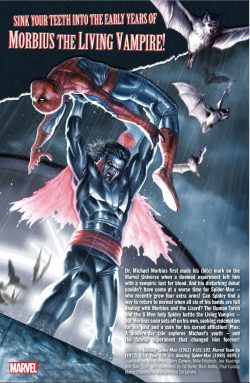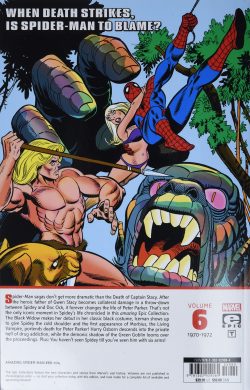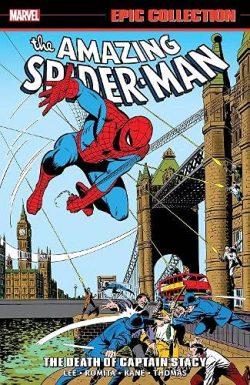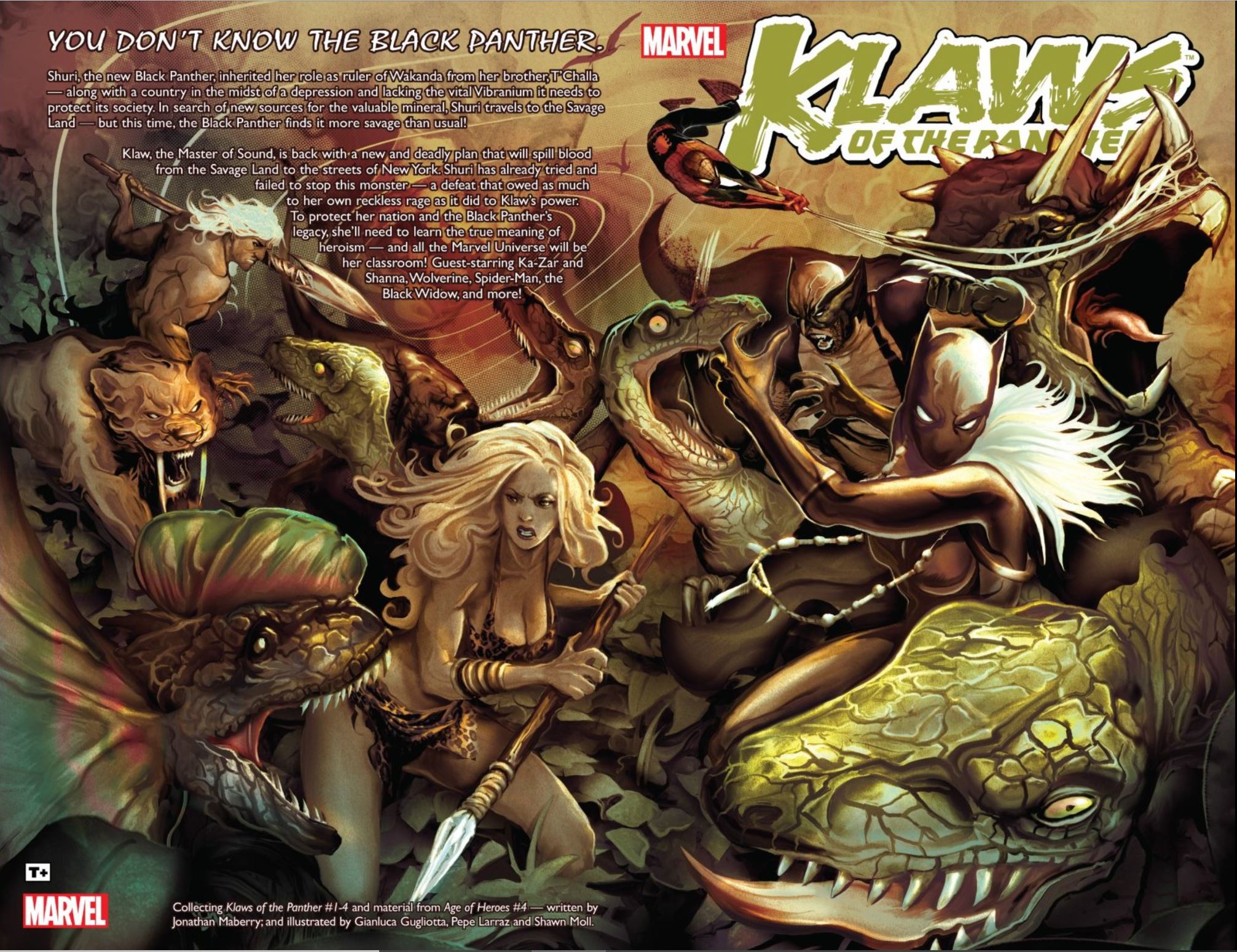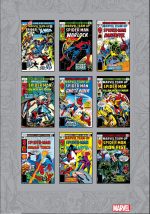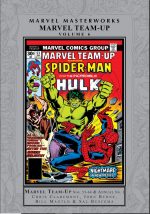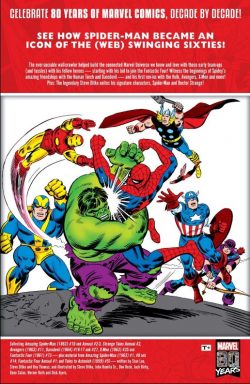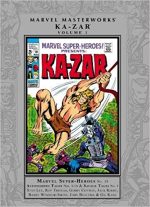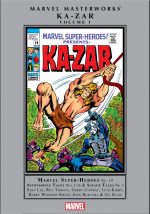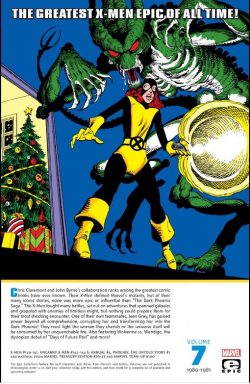
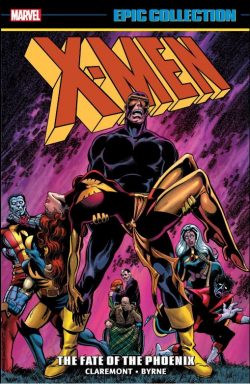
By Chris Claremont & John Byrne, Jo Duffy, Scott Edelman, John Romita Jr., Ken Landgraf, Brent Anderson & various (Marvel)
ISBN: 978-1-3029-2253-5 (TPB)
In autumn 1963, The X-Men #1 introduced Scott (Cyclops) Summers, Bobby (Iceman) Drake, Warren (Angel) Worthington, Jean (Marvel Girl) Grey and Hank (The Beast) McCoy: unique students of Professor Charles Xavier. Their teacher was a wheelchair-bound telepath dedicated to brokering peace and integration between the masses of humanity and the emergent off-shoot race of mutants dubbed Homo superior; considered by many who knew him as a living saint.
After almost eight years of eccentrically spectacular adventures the mutant misfits virtually disappeared at the beginning of 1970, during another periodic downturn in superhero comics sales. Just as in the 1940s, mystery men faded away as supernatural mysteries and traditional genres dominated the world’s entertainment fields. The title returned at year’s end as a reprint vehicle, and the missing mutants were reduced to guest-stars and bit-players throughout the Marvel universe. The Beast was refashioned as a monster fit for the global uptick in scary stories.
Everything changed in 1975 when Len Wein & Dave Cockrum revived and reordered the Mutant mystique with a brand-new team in Giant Size X-Men #1. To old foes-turned-friends Banshee and Sunfire were added one-shot Hulk hunter Wolverine, and new creations Kurt Wagner, a demonic German teleporter codenamed Nightcrawler; African weather “goddess†Ororo Monroe – AKA Storm; Russian farmboy Peter Rasputin, who transformed at will into a living steel Colossus and bitter, disillusioned Apache superman John Proudstar who was groomed into joining the makeshift squad as Thunderbird.
The revision was an instant hit, with Wein’s editorial assistant Chris Claremont writing the series from the second story onwards. The Uncanny X-Men reclaimed their own comic book with #94, and it quickly became the company’s most popular – and highest quality – title.
After Thunderbird became the team’s first fatality, the survivors slowly bonded, becoming an infallible fighting unit under the brusque and draconian supervision of Cyclops. Cockrum was succeeded by John Byrne and as the team roster changed the series rose to even greater heights.
This comprehensive compilation (available in trade paperback and eBook editions) is perfect for newbies, neophytes and even old lags nervous about reading such splendid yarns on fragile but extremely valuable newsprint paper. It celebrates the absolute peak of Claremont & Byrne’s collaborative synergy (with regular inker Terry Austin very much a part of the magical experience) as the mutants confirmed their unstoppable march to market dominance through groundbreaking, high-quality stories: specifically issues #129-143 of the decidedly “All-New, All-Different†– (latterly re-renamed “Uncannyâ€) X-Men; Annual #4, vignettes from Marvel Treasury Edition #26-27 and material from Marvel Team-Up #100, spanning January 1980 to March 1981. Also included are chronologically askew additional treats from Phoenix: The Untold Story #1 (April 1984).
Having saved Edinburgh and perhaps the world from reality-warping Proteus, Uncanny X-Men #129 sees another happy reunion as the heroes (all but the now retired Banshee) find Charles Xavier awaiting them when they reach their Westchester home in ‘God Spare the Child…’.
Thanks to sinister psionic predator Jason Wyngarde, Jean is increasingly slipping into visions of a former life as a spoiled, cruel child of privilege, contrasting sharply with her renewed love for Scott, but the home atmosphere is troubled by another discordant factor. Xavier is intent on resuming training the team, haughtily oblivious that this group are grizzled, seasoned veterans of combat, rather than the callow teenagers he first tutored.
Elsewhere, a cabal of mutants and millionaires plot murder and conquest. Black King Sebastian Shaw, White Queen Emma Frost and the rest of the Hellfire Club hierarchy know Wyngarde is an ambitious and presumptuous upstart, but the possibility of subverting the almighty Phoenix to their world-dominating agenda is irresistible…
When two new mutants manifest, Xavier splits the team to contact both, taking Storm, Wolverine and Colossus to Chicago and meeting the nervous parents of naive 13-year- old Kitty Pryde who has just realised that, along with all the other problems of puberty, she now falls through floors and walks through walls…
However, no sooner does the Professor offer to admit enrol her in his select and prestigious private school than they are all attacked by war-suited mercenaries and shipped by Emma Frost to the Hellfire Club. Only Kitty escapes, but instead of running, she stows away on the transport; terrified but intent on saving the day…
The other Homo Superior neophyte debuts in #130 as Cyclops, Phoenix and Nightcrawler head to Manhattan’s club district, tracking a disco singer dubbed ‘Dazzler’. They are unaware that they too have been targeted for capture…
However, Kitty’s attempts to free the captives at the Hellfire base forces the villains to tip their hand early and with the assistance of Dazzler Alison Blair – a musical mutant who converts sound to devastating light effects – the second mercenary capture team is defeated…
The drama concludes in #131 as Kitty is forced to frantically ‘Run for Your Life!’ – happily, straight into the arms of the remaining X-Men. Soon the plucky lass – after an understandable period of terror, confusion and kvetching – leads a strike on the lair of the White Queen: freeing Wolverine, Colossus and Xavier as Frost faces off in a deadly psionic showdown with a Phoenix far less kind and caring than ever before…
The war with the plutocratic Hellfire Club resumes in #132 as ‘And Hellfire is their Name!’ brings The Angel back into the fold. Their foes are in actuality a centuries-old association of the world’s most powerful and wealthy individuals, and Warren Worthington’s family have been members in good standing for generations. What better way of infiltrating the organisation than with someone already deep on the ultra-privileged inside?
As Wolverine and Nightcrawler scurry through sewers beneath the society’s palatial New York mansion, Warren inveigles the others in through the grand front doors, attending the year’s swankiest soiree whilst he and the Professor await events…
It’s a bold but pointless move. Although the rank and file are simply spoiled rich folk, there is an Inner Circle led by mutant supremo Sebastian Shaw comprising some of Earth’s most dangerous men and women who have been waiting and watching for the mutants-in-mufti’s countermove…
As soon as the heroes are inside, Wyngarde strikes, pushing Jean Grey until she retreats into to a manufactured persona he has woven over months to awaken her darkest desires. With the Phoenix’s overwhelming power added to the Inner Circle’s might, former friends quickly fall before the attack of super-strong Shaw and cyborg human Donald Pierce. Even Wolverine is beaten, smashed through the floor to his doom by mass-manipulating mutant Harry Leland…
As the Inner Circle gloat, Cyclops – connected to Jean by a psionic rapport – sees the world through his lover’s corrupted, beguiled eyes and despairs. However, when Wyngarde – exposed as illusion caster Mastermind – apparently stabs Cyclops, the effect on “his†Black Queen is far from anticipated…
Far below their feet, a body stirs. Battered but unbowed, ‘Wolverine: Alone!’ begins to work his ruthless, relentless way through the Club’s hired minions. His explosive entrance in #134’s ‘Too Late, the Heroes!’ gives the captive heroes a chance to break free and strike back, soundly thrashing the Hellfire blackguards. Sadly for Mastermind, not all his tampering has been expunged, and when Jean catches him, his fate is ghastly beyond imagining…
As the mutants make their escape the situation escalates to crisis level. Months of mind-manipulation finally unleash all Jean’s most selfish, self-serving desires and she shatteringly transforms into ‘Dark Phoenix’…
Manifested as a god without qualm or conscience, Jean attacks her comrades before vanishing into space. In a distant system, and feeling depleted, she casually consumes the local sun, indifferent to the entire civilisation that dies upon the planet circling it. Passing the D’Bari system is a vast and powerful ship of the Shi’ar fleet. Rushing to aid the already extinct world, they are merely a postprandial palate cleanser for the voracious Phoenix…
Uncanny X-Men #136 opens with horrified Shi’ar Empress Lilandra mobilising her entire military machine and heading for Earth, determined to end the threat of the ‘Child of Light and Darkness!’ On that beleaguered world, Cyclops has called on the Beast to build a psychic scrambler to disrupt Jean’s immeasurable psionic might, but when she cataclysmically reappears to trounce the team, the device burns out in seconds.
Jean’s gentler persona erratically appears, begging her friends to kill her before she loses control, but Dark Phoenix is close to destroying Earth before – in a cataclysmic psychic duel – Xavier shuts down her powers and establishes mental circuit breakers to prevent her ever going rogue again. With Jean left as little more than mind-maimed human, the exhausted heroes suddenly vanish in a flash of light…
The epic concludes in X-Men #137 as the outraged and terrified Shi’ar arrive in orbit to settle ‘The Fate of the Phoenix!’ With observers from the Kree and Skrull empires in attendance, Lilandra has come to exact justice and prevent the Phoenix from ever rising again. She is not prepared to accept her fiancé Charles Xavier’s word that the threat is already ended…
Summary execution is only avoided when Xavier invokes an ancient rite compelling Lilandra to instigate trial-by-combat. Relocating to the enigmatic Blue Area of the Moon (with its artificial pocket of breathable atmosphere) the mutants engage in all-out war with a brigade of cosmic champions – the Shi’ar Imperial Guard (an in-joke version of DC’s Legion of Super Heroes). However, despite their greatest efforts, the mutants are pushed to the brink of defeat.
With collapse imminent and her friends doomed, Jean’s psychic shackles slip and the Phoenix breaks free. Horrified at what will inevitably happen, Jean allows herself to be killed to save the universe…
Days later on Earth, the X-Men mourn her passing in #138’s ‘Elegy’ as Cyclops recalls his life with the valiant woman he loved so deeply – and we get a comprehensive recap of the mutant team’s career to date. Heartbroken, the quintessential X-Man resigns just as Kitty Pryde moves in…
Breaking from the monthly run, X-Men Annual #4 then describes ‘Nightcrawler’s Inferno!’ (by Claremont, John Romita Jr.& Bob McLeod) with Doctor Strange called in after Kurt Wagner is targeted by a demonic Lord of Limbo and uncovers a secret family connection to uber-witch Margali Szardos…
A new day dawns in issue #139’s ‘…Something Wicked This Way Comes!’ as the Angel returns just in time to see Nightcrawler join Wolverine in heading north for a reconciliation with the Canadian’s previous team, Alpha Flight. The visit turns into a hunt for carnivorous magical monster Wendigo, culminating in a brutal battle and an increasingly rare clean win in #140’s concluding chapter ‘Rage!’
An evocative and extended subplot opens which would dictate the shape of mutant history for years to come follows as ‘Days of Future Past’ depicts an imminently approaching dystopian apocalypse wherein almost all mutants, paranormals and superheroes have been eradicated by Federally-controlled Sentinel robots. These mechanoids rule over a shattered world on the edge of utter annihilation. New York is a charnel pit with most surviving superhumans kept in concentration camps and only a precious few free to fight a losing war of resistance.
In this dark tomorrow, aging Katherine Pryde is the lynchpin of a desperate plan to unmake history. With the aid of telepath named Rachel (eventually to escape that time-line and become a new Phoenix), Pryde swaps consciousness with her younger self in a last-ditch attempt to prevent the pivotal event which created the bleak existence where all her remaining friends and comrades are being pitilessly exterminated, one by resolute one…
‘Mind Out of Time’ sees the mature Pryde in our era, inhabiting her own 13-year-old body and leading disbelieving team-mates on a frantic mission to foil the assassination of US senator David Kelly on prime-time TV by a sinister new iteration of the Brotherhood of Evil Mutants – super-terrorists determined to make a very public example of the human politician attacking the cause of Mutant Rights…
Rocket-paced, action-packed, spectacularly multi-layered, bitterly tragic and agonisingly inconclusive – as all such time-travel tales should be – this cunning, compact yarn is one of the best individual tales of the Claremont/Byrne era, resetting the mood, tone and agenda for all the following decades of mutant mayhem…
With the timeline restored and tragedy averted, things slow down at the X-Mansion, but in the real world, John Byrne had left for pastures new. His swan song in #143 is a bombastic romp which finds lonely, homesick Kitty home alone at Christmas… except for a lone N’garai ‘Demon’ determined to eat her. Her solo trial decimates the X-Men citadel and proves once and for all that she has what it takes…
An era might have ended but mutant life goes on, as seen here in a brace of short stories taken from tabloids Marvel Treasury Edition #26 and 27.
The first is a light-hearted clash between off-duty, grouchy Logan and fun-loving, girl-chasing godling Hercules inadvertently gracing the same bar ‘At the Sign of the Lion’ (by Mary Jo Duffy, Ken Landgraf and a young George Pérez), proving exactly why most pubs reserve the right to refuse admission…
It’s accompanied by The Avenging Angel taking a ‘Joyride into Jeopardy’ courtesy of Scott Edelman, Brent Anderson & Bob McLeod before being attacked by a vengeance-crazed killer seeking payback for the sins of his father…
An intriguing safari into the unknown comes next: the untold story of how Storm and Black Panther T’Challa first met as kids in the wilds of Africa. By Claremont, Byrne & McLeod, it originated as a back-up in Marvel Team-Up #100, cunningly revealing how the kids enjoyed an idyllic time on the veldt (reminiscent of Henry De Vere Stacpoole’s 1908 novel The Blue Lagoon) until a South African commando team tried to kidnap the Wakandan prince for a bargaining chip.
Now, as adults in America they are hunted by the vicious Afrikaner Andreas de Ruyter who has returned, seeking to assassinate Ororo before exacting final revenge upon the Black Panther. Cue long-delayed lover’s reunion and team-raid on an automated House of Horrors…
Wrapping up the mutant mayhem are a selection of snippets retroactively crafted for this period of X-history. The first is a marketing oddity of the period. Phoenix: The Untold Story was released in 1984 and reprinted X-Men #137… mostly…
By all accounts, that epic conclusion was originally completed with a different ending and Jean Grey surviving the battle against the Shi’ar. That was before then Editor-in-Chief Jim Shooter overruled the outcome, decreeing she should die for her sins. You can judge the merits of the decision for yourself from the alternate version delivered here.
Also included are Jim Salicrup’s editorial ‘She’s Dead, Jim!’: ‘The Dark Phoenix Tapes – a candid conversation between Byrne, Shooter and Claremont’ on the contentious issue.
More extras include a wealth of original art pages, unseen pencils, house ads, pin-ups, lost and spoof covers; character sketches; the pertinent entry from 1981’s Marvel Comics 20th Anniversary Calendar and images from Marvel Super Hero Portfolio: The Uncanny X-Men with 4 original Byrne drawings remastered by painters Steve Fastner & Rich Larson and monochrome plates from Éditions Déese 1993 World’s Finest Comic Book Artists Portfolio by John Byrne. There’s also a gallery of X-Men collection covers by Byrne, Salvador Larroca, Bill Sienkiewicz and others.
For many fans these tales comprise the definitive X-Men. Rightly ranking amongst some of the greatest stories Marvel ever published, they remain thrilling, groundbreaking and painfully intoxicating: an invaluable grounding in contemporary fights ‘n’ tights fiction no fan or casual reader can afford to ignore.
© 2021 MARVEL


